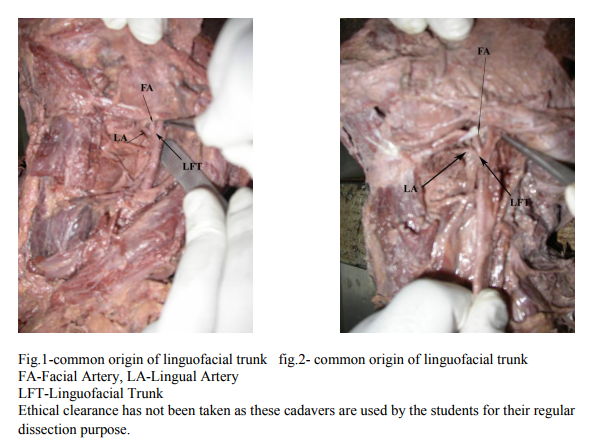IJCRR - 4(2), January, 2012
Pages: 88-90
Print Article
Download XML Download PDF
VARIANT ORIGIN OF LINGUOFACIAL TRUNK
Author: M. Pramila Padmini, B. Narasinga Rao
Category: Healthcare
Abstract:External carotid artery is a vascular system constituting the nourishment to the territorial region of head and neck. In the present report the linguofacial trunk arose from single point and ran forwards and medially and then divided into lingual and facial branches in two cadavers. Accurate anatomical knowledge of the vessels of face and neck and their variation in the
branching pattern has immense surgical importance and adds great value to the precise diagnosis in radiology.
Keywords: facial artery, lingual artery, linguofacial trunk
Full Text:
INTRODUCTION
External carotid artery is a vascular system constituting the nourishment to the territorial region of head and neck. Accurate anatomical knowledge of the vessels of face and neck and their variation in the branching pattern has immense surgical importance and adds great value to the precise diagnosis in radiology. Arterial differentiation occurs centripetally from arterial network therefore common origins occur. Lingual arteries and the arteries of facial region are often used as recipient vessels in microvascular surgery. Anatomical understanding of facial artery is important in many types of facial surgery . Knowledge of the course of lingual artery is not only a guide for catheterization during the process of superselective chemotherapy (Tatsuhiko Nakasatoa et al 20001 but also during hemiglossectomies in malignant tumours of tongue (Arnold komisar 19862 ).
Observations: Anatomical variations of the vessels of the neck region were carried out on 20 cadavers (18 male and 02 female during the years 2006-2010 ). Our results briefly are as follows:
(1) The noncommon-trunk type of the external carotid artery (in which each branch arises separately from the external carotid artery) was found in 17 cases,
(2) truncus linguofacialis type was found in 2, and
(3) truncus thyrolinguo-facial type was found in 1 case .
The lingual artery and facial artery usually take origin separately from external carotid artery. In the present report the linguofacial trunk arose from single point and ran forwards and medially and then divided into lingual and facial branches in two cadavers( fig.1, fig.2) . The lingual artery passed horizontally and disappeared underneath the hyoglossus muscle.

DISCUSSION Embryology: The ventral aorta proximal to the third arch has become the common carotid artery. It divides into ventral pharyngeal artery and internal carotid artery (future external carotid artery). The distal part of ventral pharyngeal and ventral remnants of first and second aortic arches will develop into linguofacial system. Basmajian 19933 , Shangkuan et al. 19984 , Shima et a,l. 19985 observed the presence of the linguofacial trunk in two hundred and eleven cases, 20% showed the trunk; Shangkuan et al4 observed that in twentyfive cases, 20% showed the trunk and Shima et al., 5 described that in thirty cases, 21.7% showed the trunk. Linns et al 20056 during dissections in corpses in the anterior trigone region of the neck, observed the presence of the linguofacial trunk in their survey have obtained results similar to that of above authors .
Shima, Harunobu D.D.S et al 19987 in their study of Anatomy of Microvascular Anastomosis in the Neck found truncus linguofacialis in 21.7 percent cases. In the present study linguofacial trunk is observed in 10% of cases. The difference in percentage is may be due to study in less number of cadavers.
References:
1. Tatsuhiko Nakasatoa,b , Kenichi Katoha , Miyuki Sonea , Shigeru Eharaa ,Yoshiharu Tamakawaa , Hideki Hoshia and Saburoh Sekiyamaa Super selective Continuous Arterial Infusion Chemotherapy through the Superficial Temporal Artery for Oral Cavity Tumors , American Journal of Neuroradiology 21:1917-1922 (11 2000) © January 2000
2. Arnold komisar, m.d., d.d.s. The applications of tongue flaps in head and neck surgery* vol. 62, no. 8, october 1986
3. Basmajian, J. V. Anatomia de Grant. 10?ed. São Paulo, Manole, 1993.
4. Shangkuan, H.; Xinghai, W. ; Zengxing, W.; Shizhen, Z.; Shiying, J. and Yishi, C. Anatomic Bases of Tongue Flaps. Surg. Radiol. Anat., 20(2):83-8, 1998.
5. Shima, H.; Luedinghausen, M. V.; Ohno, K. and Michi, K. Anatomy of Microvascular Anastomosis in the Neck. Plast and Reconstructive Surgery,101(1):33-41, 1998.
6. Lins A. C. C. S.; cavalcanti, s. J. and do nascimento, l. D. Ligadura extraoral de la arteria lingual: estudio anatómico y topográfico. Int. J. Morphol., 23(3):271- 274, 2005.
7. Shima, Harunobu D.D.S., Ph.D.; von Luedinghausen, Michael M.D.; Ohno, Kohsuke D.D.S.; Michi, Ken-ichi D.D.S. Anatomy of Microvascular Anastomosis in the Neck January 1998 - Volume 101 - Issue 1 - pp 33-41
ACKNOWLEDGEMENT Authors acknowledge the immense help received from the scholars whose articles are cited and included in references of this manuscript. The authors are also grateful to authors / editors / publishers of all those articles, journals and books from where the literature for this article has been reviewed and discussed.
Figure legends 1.Fig.1-common origin of linguofacial trunk in cadaver 1 2.
Fig.2- common origin of linguofacial trunk in cadaver 2
|






 This work is licensed under a Creative Commons Attribution-NonCommercial 4.0 International License
This work is licensed under a Creative Commons Attribution-NonCommercial 4.0 International License